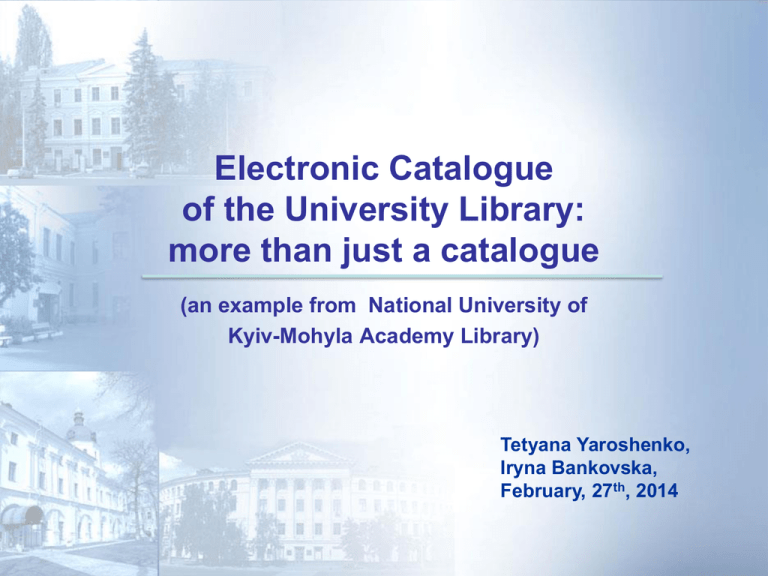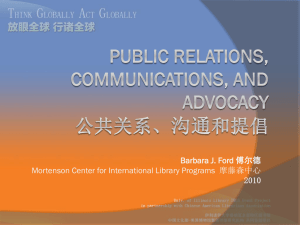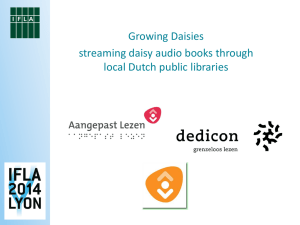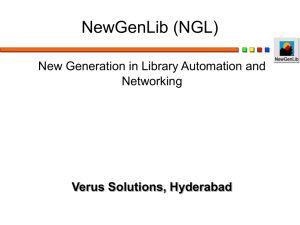Main OPAC features
advertisement

Electronic Catalogue of the University Library: more than just a catalogue (an example from National University of Kyiv-Mohyla Academy Library) Tetyana Yaroshenko, Iryna Bankovska, February, 27th, 2014 Overview 1. 2. 3. 4. Ukraine and Ukrainian Libraries General information on NaUKMA catalogue Main OPAC features Electronic catalogue management Ukraine • • • • Population - 46,011,300 Area - 603,628 km Official language – Ukrainian Kyiv – the capital History: • Human settlement in the territory of Ukraine dates back to at least 4500 BC, Neolithic Cucuteni-Trypillian Culture • Kievan Rus – from the 9th century • Independence after the dissolution of the Soviet Union in 1991 Libraries in Ukraine •The oldest Library – The Library of Yaroslav the Wise - the first state library of Kievan Rus (1037) •Monastery Libraries – Kyevo-Pechersky, KyevoMezhyhirsky, Chernigiv and Pochayiv (from the11th century) •Libraries of Lviv, Kyiv, Chernigiv, Lutsk, Ostrog Brotherhoods (the16th-17th centuries) •The oldest Universities Libraries in Lviv (1608), Kyiv Mohyla Academy (1615), Kharkiv (1805), Odessa (1817), Kyiv (1834 ), Chernivtsi (1852) Libraries in Ukraine - 2014 • 37 466 – Total • 9 national • 18 000 – public libraries • 800 + – universities libraries • 900 + – medical libraries Total book collection – 400 mln.vol. Ukrainian Libraries from 1991 ”New library policies in Ukraine based on free access to ideas, library materials and services. Intellectual freedom issues are the basis on contemporary library and information policies in Ukraine “ Libraries and Intellectual Freedom: Ukraine – FAIFE World Report, IFLA, 2003 Ukrainian Library Association (1995) E-catalogs • Only 11-12 % libraries has Internet access • Only 440 public libraries (from 18000) has e-catalogues – 2,4% • Only 4 used such ILS as ALEPH • Another domestic and Russian software: UFD, IRBIS, MARC SQL. • 1 library use KOHA (FOSS) Challenges for Ukrainian Libraries In general: • Postcomunistic factor (more than 70 years libraries had been working as ideological centers), • The bad state funding and support, • The absence of many very important standards for some processes, • The lack of personnel. Challenges for Ukrainian Libraries In cataloguing: • The absence of the corporate projects. There is no National Center for creation and dissemination of bibliographic or authority records. • The absence of the coordinated cataloguing standards (in use MARC 21 and UniMARC at the same time), • No attempts to discuss on the cataloguing problems of electronic resources or RDA implementation. • Federative search and discovery systems are used only in some lonely libraries in the country. BIBLIOMIST • $25 mln. Bill and Melinda Gates Programme (20092014) • modernizing access to information in public libraries (Equipping 2000+ public libraries + Trainings) National University of “Kyiv-Mohyla Academy” • Founded in 1615 (till 1815) • Rebirth in 1991 • Oldest University in Ukraine • 1000+ Staff • 450 Researchers • 3,500 Students • 7 PhD Programme • In the top of 1% of the Ukrainian University The Library is a heart of University • From 1st book in 1991 – to 1,6 mln. collection now • 53% - e-collection • 9 libraries at the campus • Staff -64 • 7 269 users • Average Day Visits in 2013 – 2034 General information on catalogue • Card catalog is used until 1996 • ILS - ALEPH 500 (Ex Libris) (the automation project has been started in 1996) • MARC format for Bibliographic and Authority data MARC 21 • 311 000 bibliographic records • 700+ authority records • 13 virtual collection • 600 000 Items ILS ALEPH 500 • • • • • • • • • • Manages all aspects of the library work Flexible Open Scalable Expandable Trustworthy Multilingual Client/server architecture Cataloging with extensive control Customer support 2013 Statistical Report for ALEPH 500 • • • • • • • • • ILS Satisfaction -7 ILS Functionality -7 Print Functionality- 8 Electronic Functionality – 5 Company Satisfaction -7 Support Satisfaction - 7 Support Improvement - 5 Company Loyalty - 7 Open Source Interest -2 Library Technology Guides - http://www.librarytechnology.org/survey2013-product-report.pl?CurrentILS=ALEPH 500 General principles of catalogue structure • • • • User-friendly intuitive interface; Broad search possibilities; Tools for search results processing; The best practices of other libraries that use the same ILS; • 2 interface languages – Ukrainian & English . General principles of catalogue structure Main OPAC features • Special virtual collection for Course Reserves. Collection consists of course-related materials recommended by University professors. Main OPAC features Simple work with new acquisitions. Information is accessible via e-mail and RSS feeds. Each library patron (and each catalogue user) can choose topic on which he/she’d like to receive information and the way in which this information could be delivered. The new acquisitions The SDI request example Main OPAC features • Library catalogue gives access to the electronic resources: digitized items provided by university professors and lecturers for course learning, uploaded bibliographic records from purchased databases. Main OPAC features • The catalogue contains some virtual collections related to the university materials: Scholars works, Publications about the University, materials from University Institutional Repository, full text articles from "Scientific papers of NaUKMA" serials. Main OPAC features • Part of the catalogue – the American library catalogue. This is public library and contains virtual collections that is more interesting for public library patrons. Main OPAC features Web-OPAC is source for extended communication with patrons. Patrons could receive the email letters when hold request is fulfilled, hold request is cancelled, courtesy notices or overdue letters Main OPAC features • Catalogue has the elements of interactivity. Each library patron can become the member of library collection development team. The acquisition request via the OPAC allows the patrons to request materials for purchasing that are absent in library at the moment. Main OPAC features • Authority data – Name Authority Files: authority file of personal names and authority file of personal names university scholars. Main OPAC features • Link to Google Books Service which is displayed from record’s full view. Main OPAC features • As a searching aid on different topics, catalogue shows related books from the record’s full view. There are established such types of relationship: books frequently read by people who have borrowed this particular item, books with equal or the same subject headings, or other editions of the same published work. The List of Related books Web OPAC management • The most important thing in the library online catalogue management is creation of strong relationship between technical specialists and all library departments. • It requires the different work groups to maintain different functions of the ILS. WEB-OPAC/ILS management at the Library Summary The Library work Experience Each Library System should be adapted to the Library policy and practice. Future and Path of development The Integration with the Discovery System (EDS or maybe some day with Primo) We are ready to share the experience we have and we invite you to cooperate with us Thank You! Questions? More Information? yaroshenko@ukma.kiev.ua bankovskaim@ukma.kiev.ua The presentation is licensed with Creative Commons Attribution 3.0 License







